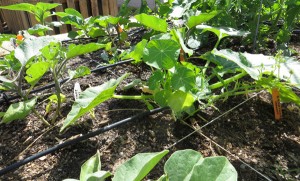Plant a Square Foot Garden
Those of us who have been gardening in the Southwest for more than a few seasons have probably come to learn that the advice found in most gardening books and magazines just doesn’t work in our climate. One of the first lessons learned comes from following generic planting recommendations printed on seed packets. The planting dates for our area are usually wrong and the recommendations often call for planting in long, mounded rows.
In other parts of the country, where rain and space is plentiful, row planting makes sense. Here in Tucson however, planting this way can lead to thirsty plants. But even after converting to basin-style gardening, which is more appropriate for our area, many gardeners still continue to plant in row fashion by scattering large amounts of seeds along shallow trenches. Not only is this technique wasteful, but it leads to more work and crowded plants.

An example of square foot gardening at The Garden Kitchen in South Tucson, where Brandon Merchant teaches classes once a month.
photo: Brandon Merchant
Fortunately, there is an alternative to row planting that will not only save you time, but will also allow for increased yields while reducing the need for weeding and the amount of water required to keep your garden healthy. I’m speaking of the square foot gardening method; a system that was developed by civil engineer Mel Bartholomew in the 1980s.
Unlike row planting, square foot gardening involves creating small but densely planted gardens with the goal of maximizing yields from smaller spaces. The technique borrows heavily from earlier sustainable agriculture methods such as French intensive planting and biointensive agriculture, but it is designed for the relatively small backyard vegetable garden.
Any garden space can be converted into a square foot garden by following a few simple steps. First, in order for vegetables to be planted densely using the square foot method, your soil must be heavily amended or even replaced with a nutrient-dense growing medium. The most common medium is a mixture of compost, coco coir and vermiculite. This mixture of ingredients provides the perfect balance of nutrients, water holding capacity and soil aeration that densely planted gardens thrive in.
The ratio at which these ingredients are mixed can be adjusted to fit your garden and your budget. In the bestselling book Square Foot Gardening, Mel Bartholomew recommends an even mix of 33% of each ingredient; however these are only recommendations and need not be followed to a T.
Although the soil mix is very important, what ultimately defines a square foot garden is the layout. Prior to planting, the garden is first divided into one foot by one foot squares. You can do this easily by using garden twine and tent stakes, or if you’re feeling industrious you can make a more permanent grid using lumber.
Within each square of the grid, crops are planted in a pre-defined pattern. For example, in one square foot you could either plant nine turnips, 16 carrots or one eggplant. Every square foot has a maximum number of each crop that can be planted in it. Although it is not necessary to plant the recommended maximum number of plants, you should never exceed the recommendation. When planting from seed, great care should be taken to not over plant; two or three seeds per hole are usually sufficient. What may seem like a meticulous task at first will save you time in the long run.
Square foot gardening can also be combined with organic gardening techniques such as succession planting, intercropping, cover cropping, and companion planting. Crops with similar square foot growing requirements can be combined for more effectiveness. For example, one square foot could hold a mixed combination of 16 radish and carrots.
There are many square foot garden planting guides available online for free or you can learn more by picking up a copy of Square Foot Gardening at your local book store or library. Another great way to learn how to properly plan your square foot garden is to subscribe to an online garden planner service such as GrowVeg.com or the Mother Earth News online garden planner. Each of these programs offers a free 30 day trial and both allow users to create their own unique garden plans using the square foot gardening method.
Brandon Merchant is the proprietor of Southwest Victory Gardens. Visit his website at SouthwestVictoryGardens.com.
Category: Community, FOOD & DRINK, Nature




